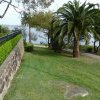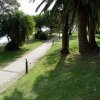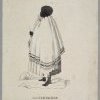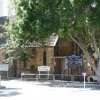1860s
1860s?
Birth of Hannah Matilda Ashby, daughter of James Ashby.
1860s-80s
At Christmas time Aboriginal people come in large numbers to camp at Cremorne Reserve in Cameragal country. They receive the annual gift of a blanket each, given by the government. Traces of Christmas feasts have been found in the shell middens around the caves. (Bennett 1960, Manuscript, Local History section, North Sydney Library)
1862
Death of Queen Gooseberry, at 78. Her father was from the southern Sydney area. After Bungaree’s death she has settled around Camp Cove with other displaced Aboriginal people. She wears a breast plate with her name on it. Wrapped in a blanket, her head covered by a scarf and with a clay pipe in her mouth, she is a familiar Sydney personality. Her grave is in the Presbyterian section of Botany Cemetery. “In memory of Gooseberry Queen of the Sydney Tribe of Aborigines”.
Human remains, thought to be Aboriginal, are found by a boy in bush between the Quarantine Ground and Fairy Bower.
1863
1866
Death recorded of Aboriginal man, Boomer at Ryde.
1868
Corroborees held at Manly on the site of several churches above Careening Cove. During the visit of Albert Prince of Wales, the Koori visitors come from different Guringai, Darkinyung and Garigal areas to dance a large corroboree. They camp at ‘Fassifern’ a property belonging to the Loxton family, on a flat piece of ground between Kurraba Rd Bridge and Aubin St near a waterfall, at rear of Dalmarnock cottage. They camp every year to receive annual blanket and rations for Queen’s birthday. LF Mann writes, “I well remember watching a number of the original inhabitants of this country camping and practising for this great event, making boomerangs from local trees and using them, as they danced around, their bodies painted in many designs.” (Mann 1932)
A well known aboriginal chief named Thomas Booker died at Noraville, Brisbane Water at the 6th instant and was buried in the Church of England Cemetery at Nora on the following day. His remains were placed in a neat coffin, and in accordance with the native custom, all his goods and chattels were buried with him, consisting of hat, coats, cap, blanket, pipes, boo’s, trousers, gloves, shot and match box, belt and money. The above inventory cuts but a sorry figure as compared to the treasures buried by the late Queen Itasoherina of Madagascar, as reported in this journal a few days since. Of the once powerful and numerous tribe of the Brisbane Water district, five only remain – three males and two females. The deceased was probably under forty years of age. Drink and exposure as in most cases of Aboriginals were the cause of death, accelerated by the visit to Sydney to do honour to H.R.H the Duke of Edinburgh. Booker was well known to many gentlemen in Sydney who take an interest in the aborigines. It is highly probable, had his early associations been different, and had he been properly educated, that he would have been a man of mark, being possessed of great natural ability and cleverness. In committing his body to the earth, we were forcibly reminded of the text. “To whom much has been given, from him much shall be required; and to whom little has been given, from him little shall be expected,” and from the fact that we all shall be judged by the light that is in us. In closing this brief notice, we would willingly engrave this good deed on brass, and write the others in the sands of the sea shore. 14th August, 1868 – communicated.















 Trudy Smith, Lynette Robley, Reta Smith, Margaret Robinson, Tracey Howie.thumbnail.JPG)

